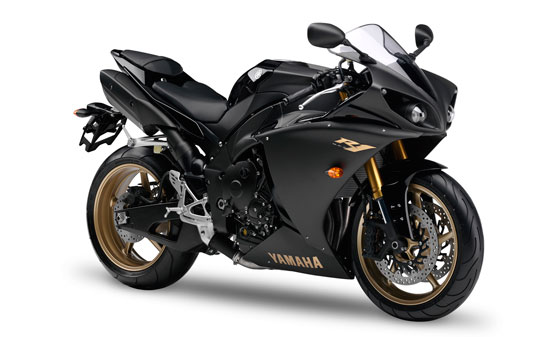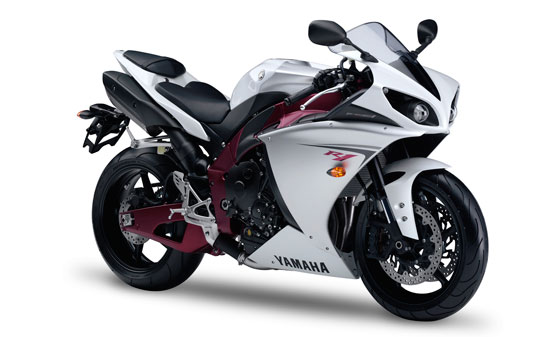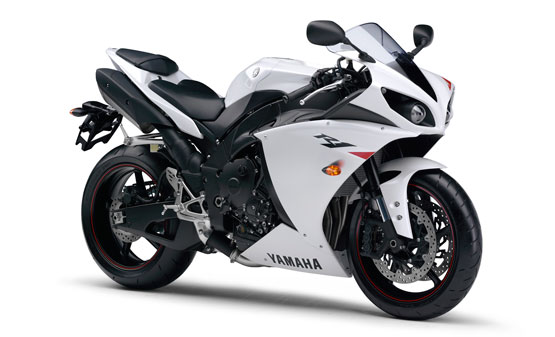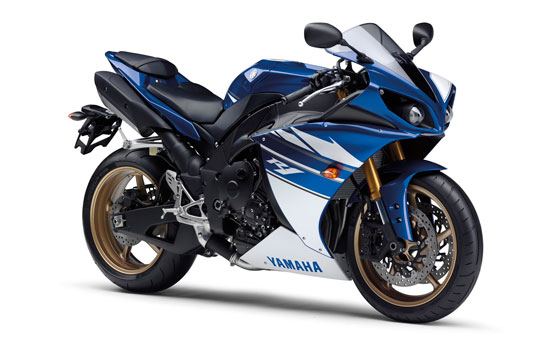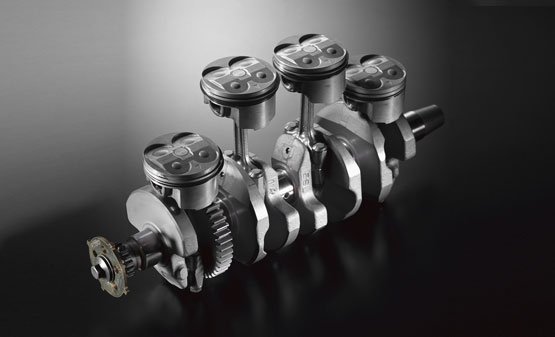2009 to 2011 – R1/YZF-R1 revolutionary new engine
Page 7 of 7
<< Page Back – Page Forward >>
“The ultimate cornering Master (Yamaha R1/YZF-R1)” – Yamaha
2009 Yamaha R1/YZF-R1
After 10 years on the market, now comes a very big step: A completely new R1 with ‘irregular firing order’ engine. This technology is derived from MotoGP, where it was developed for the famous M1 on which Valentino Rossi won the championship in 2008 (also using this irregular firing order to improve traction and control in the corner). This technology gives the engine a completely different sound, more of a ‘roar’ than ever before.
The fuel injection system gained a second injector which complements the main injector, helping the engine’s mid to high-speed range for better response and acceleration. A choice of engine mappings is now available to suit the power delivery to the rider’s style of riding.
The exhaust system is a 4 into 2 into 1 into 2 system ensuring effective exhaust pulsations in line with the new engine firing order. The mufflers are fitted tightly under the seat and triangular shaped.
The engine delivers 182 HP at 12.500 rpm. The dry weight is not stated anymore due to an agreement between manufacturers. From now on only the ‘Wet’ weight will be mentioned, including the liquids and a full fuel tank, and the new YZF-R1 weighs in at a ultra competitive 206 kg.
The chassis is a completely new design to exploit the full potential of the new engine. The engine is once again used as a stressed member of the frame. The cylinders are angled at 31 degrees forward and the engine mounting is more forward to help the front wheel ‘stick’ to the tarmac. The footrests are adjustable and the rear frame is made of lightweight magnesium.
The rear shock’s compression damping is now adjustable at both high and low speed damping.
In the front fork, the rebound damping is in the right fork and the compression in the left fork allowing a more precise level of adjustment. This also simplifies the oil flows and makes for easier adjustability with both adjustments on top of the forks.
The bike’s bodywork is totally new. The projector headlights have a novel low/high beam switching mechanism inside them, so that only 2 projectors are needed in total, instead of 2 low beam plus 2 high beam projectors.
2010 Yamaha R1/YZF-R1
2010 – Colouring and Graphics update for 2010.
The Bark is Bad. The Bite is Badder.
Introducing the 2010 R1 … Yamaha’s technical “Tour de Force.”
The MotoGP-inspired R1 is the most advanced Open-class production motorcycle.
The R1 has been designed to be the “Ultimate Cornering Master” of the open super sport class and one of the keys to incredible handling lies partly in the chassis but equally as important, in its ability to put useable power to the ground. This revolutionary cross-plane crank R1 delivers as much power as the rider wants, exactly when the rider wants it … by a simple twist of the right wrist; leaving the rider feeling like they are directly connected to the rear wheel of the new R1.
Forget everything you ever knew about the supersport liter class. The 2010 Yamaha YZF-R1 is unlike anything before. That’s because it’s the world’s first production motorcycle with a crossplane crankshaft. The result? Incredibly smooth power delivery and outrageous torque for a rush like you’ve never experienced.
The 2010 Yamaha R1 represents a paradigm shift in technology, performance and controllability among litre class sport bikes. Inspired by Yamaha’s M1 MotoGP race bike, this latest generation R1 features a crossplane crankshaft design with an uneven firing order to provide outstanding yet easy to control torque and an exceptionally linear throttle feel never experienced before. But there is far more to the R1 than just a revolutionary engine.
2010 Yamaha R1/YZF-R1 LE Limited Edition
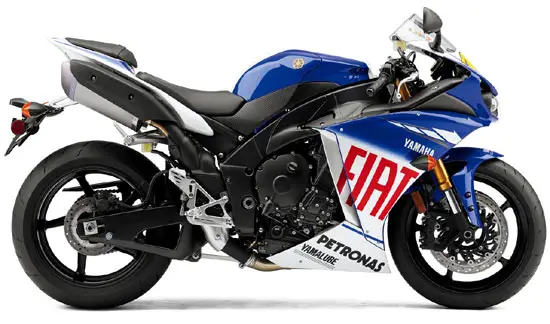
2010 Yamaha R1/YZF-R1 LE Limited Edition
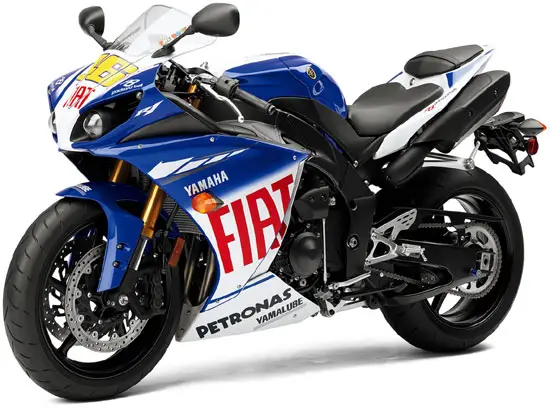
2010 Yamaha R1/YZF-R1 LE Limited Edition
The new 2010 Yamaha YZF-R1 LE sports Valentino Rossi livery just like his YZF-M1 MotoGP bike, but will come in very limited numbers.
MotoGP Technology with looks to match.
The new 2010 Yamaha YZF-R1LE not only gives you much of Valentino Rossi’s championship technology, but also his championship look and style. The R1 is the first ever production motorcycle with a crossplane crankshaft. The Result? Outrageous torque and raw, high-rpm power providing incredibly smooth power delivery out of the corners. While the bold Fiat Yamaha team graphics provide incredibly smooth style.
2010 Yamaha R1/YZF-R1
The MotoGP-inspired R1 is the most advanced Open-class production motorcycle.
The 2011 Yamaha R1 represents a paradigm shift in technology, performance and controllability among litre class sport bikes. Inspired by Yamaha’s M1 MotoGP race bike, this latest generation R1 features a crossplane crankshaft design with an uneven firing order to provide outstanding yet easy to control torque and an exceptionally linear throttle feel never experience before. But there is far more to the 2011 Yamaha R1 than just a revolutionary engine.
The 2011 R1 … Yamaha’s technical “Tour de Force.”
The R1 has been designed to be the “Ultimate Cornering Master” of the open super sport class and one of the keys to incredible handling lies partly in the chassis but equally as important, in its ability to put useable power to the ground. This revolutionary cross-plane crank R1 delivers as much power as the rider wants, exactly when the rider wants it … by a simple twist of the right wrist; leaving the rider feeling like they are directly connected to the rear wheel of the revolutionary R1.
The Bark is bad. The bite is badder.
Forget everything you ever knew about the supersport litre class. The all new 2011 Yamaha YZF-R1 is unlike anything before. That’s because it’s the world’s first production motorcycle with a crossplane crankshaft. The result? Incredibly smooth power delivery and outrageous torque for a rush like you’ve never experienced.
2011 Yamaha YZF-R1 model Features
Fuel Consumption * 14kpl/40mpg(Imp)
998cc, DOHC, 4-valve, in-line 4 with revolutionary “crossplane” crankshaft
Compact Deltabox chassis with fully adjustable suspension
Yamaha R1: Engine with uneven firing order
“The ultimate cornering Master” was the key phrase in the development of the Yamaha 2009 YZF-R1. Yamaha engineers took this challenge so serious that they developed a revolutionary new engine layout, with a cross-plane crankshaft and irregular firing order.
At first we’ll explain the basics for a 4-cylinder engine and then we’ll explain what makes the 2009 R1 engine so special.
4-cylinder engine basics
Yamaha’s YZF-R1 engine is a four-stroke, four-cylinder engine. Each cylinder displaces 250cc, and the combination of 4 cylinders gives a total of 1000cc (4 x 250cc = 1000cc).
As this engine is a four-stroke engine a complete cycle with 1 cylinder’s ignition of this engine takes 720 degrees of crankshaft rotation (or two full turns of the crankshaft). This cycle happens in four stages as listed below:
1) SUCK
If we begin with a piston at the top of a cylinder and push this piston down to the bottom of the cylinder. This will rotate the crankshaft through 180 degrees and create a ‘vacuum’ in the cylinder. While this ‘vacuum’ is being created two valves at the top of the engine will open and the negative pressure will suck in the mixture of air and fuel into the cylinder (with the help of the injector and possibly forced air intake depending on the speed of travel, etc). The valves at the top of the cylinder will close when the piston reaches the bottom of this stroke.
(Total of 180 degrees of crankshaft rotation so far)
2) SQUEEZE
The crankshaft must then rotate through another 180 degrees, pushing the piston back to the top of the cylinder compressing the fuel/air mixture (by a ratio of 12.7:1 on the 2009 YZF-R1 engine).
(Total of 360 degrees of crankshaft rotation so far)
3) BANG
The spark plug must then ignite the fuel/air mixture, pushing the piston back to the bottom of the cylinder with considerable force. This turns the crankshaft through another 180 degrees of rotation and is often referred to as the ‘Power Stroke’.
(Total of 540 degrees of crankshaft rotation so far)
4) BLOW
Now we have a cylinder with exhaust gas, so the 2 exhaust valves at the top of the cylinder open, the crankshaft rotates through its final 180 degrees, pushing the piston back to the top of the cylinder (with the piston pushing the exhaust gas out of the open valves). When the piston reaches near to the top of this phase the exhaust valves will close and this whole 4 step (or 4-stroke) cycle can begin again.
(Total of 720 degrees of crankshaft rotation so far)
Firing order
Yamaha’s YZF-R engines upto and including the 2008 YZF-R1 model have used a 180 degree firing order. This means that for every 180 degrees that the crank-shaft rotates one of the spark-plugs fires producing a ‘power stroke’ or ‘pulse of power’ for that cylinder. As there are four cylinders this means the power of the engine can be spread evenly throughout the full 720 degrees of the 4-stroke engine cycle as outlined above. Pistons 1 and 4 rise and fall together and pistons 2 and 3 rise and fall together. The order in which the spark-plugs fire and the cylinders create power is 1 – 3 – 4 – 2; this arrangement helps disperse the pressures and stresses the engine has to tolerate to produce such high power and fast revs.
When considering the power that an engine creates there are two main figures that are important, the Torque and the Maximum Power.
The torque is the tendency of a force to rotate an object around its axis. It is measured in force times distance (to the axis, as a lever). In this respect, it is directly related to the actual pulling force of the engine and is most noticeable when cornering (whilst using midrange power).
The maximum power output an engine produces is the ‘work’ it actually does in a certain period of time. This is related to the force also, times the distance over which the force is exerted, in a certain period of time.
By definition, at higher rpm the distance over which the force is exerted is higher and therefore the maximum power figure can be found near the maximum rev speed of an engine.
When Yamaha’s engineers consider the torque that is created by an engine they consider two different types of torque.
– The first and most obvious torque that is created is with the combustion of fuel in a cylinder; forcing the piston down and creating a power pulse producing torque. This is called combustion torque and is directly controlled by the riders input on the throttle.
– The second torque that is created is slightly more complex. Due to the weight and mass of the pistons, conrods and crankshaft when they spin they create inertia. This Inertia continues after the initial forces from the combustion have disappeared. The weight and mass of the rotating parts in the engine continue to spin.
Another example of these forces can be found when spinning a coin on a table. Once you spin the coin and release it from your fingers the coin will continue to spin even though you are not ‘powering’ it. The initial input from your fingers is similar to composite torque – providing a positive input of torque, the reason the coin will continue to spin is because of the inertia – the forces produced by the rotating weight or mass in the coin.
When we consider a conventional 4 cylinder crankshaft we have two pistons and con-rod’s rising and falling together. (the outer two pistons rise and fall together, also the inner two pistons rise and fall together). The weight and mass of this type of crankshaft creates large fluctuations in the inertial torque which is not directly influenced by the riders input on the throttle (because the inertial torque is related to the mass of the rotating parts – which can not be changed by the rider).
The new R1 engine’s revolutionary layout
The 2009 YZF-R1 engine changes the crankshaft layout so that one piston rises and falls alone at any time (pistons do not rise and fall in pairs as with a conventional engine), spreading the weight and mass evenly through-out the crankshaft rotation and smoothing out the fluctuations in inertial torque. Yamaha call this type of crankshaft arrangement a “Cross-plane Crankshaft” because the pistons are placed at even 90 degree intervals of rotation across the crankshaft, giving two planes that cross at 90 degrees angle – hence the name “Cross-plane Crankshaft”. This creates a smoother torque delivery through-out the entire rev range and gives the rider a more accurate feeling of the power that the engine is producing.
With the more direct feeling that the cross-plane crankshaft gives to the rider it is easier to feel the grip from the rear wheel and allows the rider to accelerate earlier compared to the feeling when riding pre-2009 YZF-R1 engines.
This technology was developed and fine-tuned on the YZR-M1 and has been an instrumental part of the success Yamaha have achieved in MotoGP. Up to the 2009 YZF-R1 the cross-plane crank-shaft has never been fitted to a production motorcycle due to the complicated shapes in the crank-pins and crankshaft parts, and vibrations associated by this type of engine layout. For this reason the 2009 YZF-R1 has been fitted with a primary coupling balancer to minimize the vibrations.
This new type of engine configuration is one of the key components to create the ultimate cornering 1000cc motorcycle. Yamaha has developed a fantastic engine that will show its advantages on the racetrack; and also on the road.
Uneven firing
The new engine’s uneven 270° – 180° – 90° – 180° firing interval creates a whole new feel to the inline 4-cylinder engine, giving the rider a more precise and immediate feeling of control over the torque output levels.
The asymmetric firing sequence achieves a strong pulse at low to mid rpm range. together with excellent linearity across the whole rpm range.
This new engine feature, coupled with the cross-plane crankshaft gives the 2009 YZF-R1 a unique feeling and performance character unlike any other production motorcycle on the road today!
Sound
The sound of the engine will be one of the first things to notice when starting the engine; a deeper growl beckons the rider to go for a ride.
As the road begins to weave and corners appear and disappear behind you its easily noticeable how much traction the rear tyre now offers. Accelerating from a corner now becomes easier and more stable, in fact you can begin to accelerate so much earlier in the corner that you feel amazed and excited by the new level of fun you have just stumbled upon.
The flexibility of the engine and new found grip opens up a whole new experience of riding – whether using the middle of the rev range or the peak power at maximum revs the YZF-R1 keeps you both excited and reassured.
This new uneven firing order YZF-R1 engine is another example of Yamaha pushing the limits of the production motorcycle and delivering racetrack technology directly to the faithful R-series riders.
Road riding has reached a new level –Be the one!
2009 Yamaha R1/YZF-R1 Specifications
Engine
Engine type 4-stroke, forward-inclined parallel 4-cylinder, 4-valves, DOHC
Engine cooling Liquid-cooled
Displacement 998 cc
Bore x stroke 78.0 x 52.2 mm
Compression ratio 12.7:1
Maximum power 133.9 kW (182 PS) @12,500 rpm
Maximum torque 115.5 Nm (11.8 kg-m) @ 10,000 rpm
Lubrication system Wet sump
Fuel System Fuel Injection
Clutch type Wet, multiple-disc coil spring
Ignition system TCI
Spark plug LMAR9E-J
Starter system Electric
Transmission system Constant mesh, 6-speed
Primary reduction ratio 65/43 (1.512)
Secundary reduction ratio 47/17 (2.765)
Ratios gearbox 1st 38/15 (2.533)
Ratios gearbox 2nd 33/16 (2.063)
Ratios gearbox 3rd 37/21 (1.762)
Ratios gearbox 4th 35/23 (1.522)
Ratios gearbox 5th 30/22 (1.364)
Ratios gearbox 6th 33/26 (1.269)
Other Max. speed: 285 kmh
Chassis
Chassis Aluminium Deltabox
Front suspension system Telescopic forks, USD, Ø 43 mm
Front wheel travel 120 mm
Rear suspension system Swingarm, link suspension
Rear wheel travel 120 mm
Caster angle 24º
Trail 102 mm
Front brake Dual discs, Ø 310 mm
Rear brake Single disc, Ø 220 mm
Front tyre 120/70 ZR17M/C (58W)
Rear tyre 190/55 ZR17M/C (75W)
Other Turning radius: 3.5 m; Battery: 12V 8.6Ah
Dimensions
Overall length 2,070 mm
Overall width 715 mm
Overall height 1,130 mm
Seat height 835 mm
Wheelbase 1,415 mm
Minimum ground clearance 135 mm
Service weight (incl. liquids) 206 kg
Fuel tank capacity (reserve) 18 L
Engine oil tank capacity 3.73 L
Radiator capacity 2.84 L (incl. all routes)
Equipment
Headlight low/high beam H7 55W
Speedometer/RPM counter Digital/Analog
Clock Digital
Other Trip meter: Digital; Water temperature meter: Digital
Specifications and appearance of Yamaha products shown here are subject to change without notice and may vary according to requirements and conditions. For further details please consult your Yamaha dealer.

